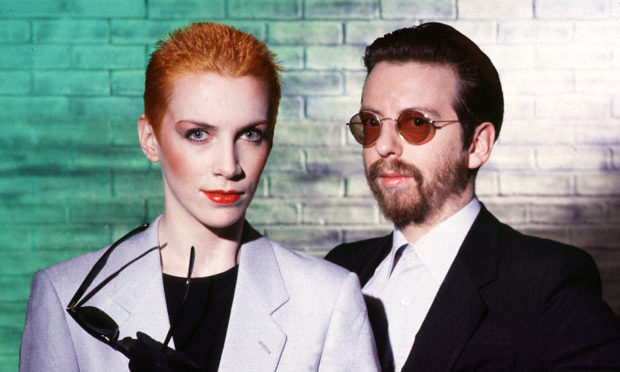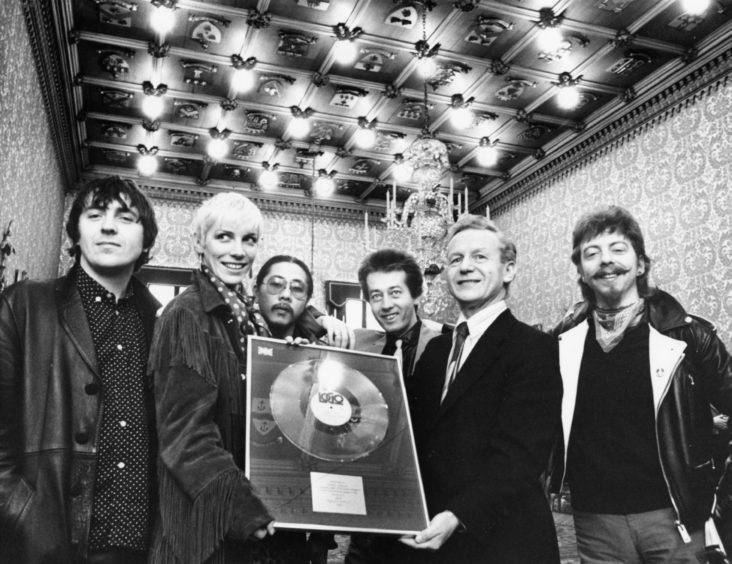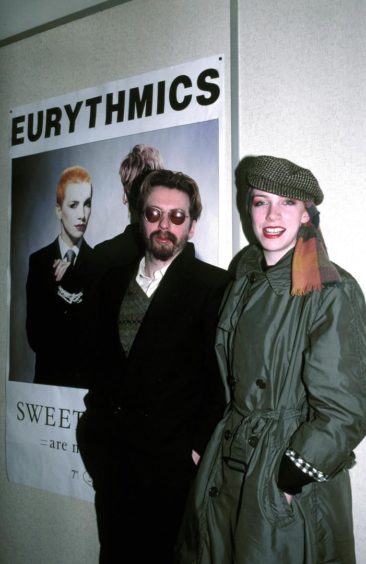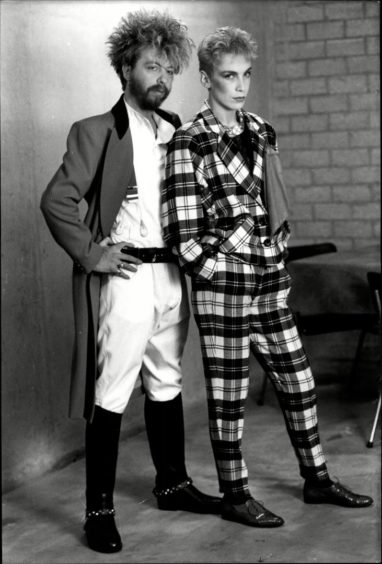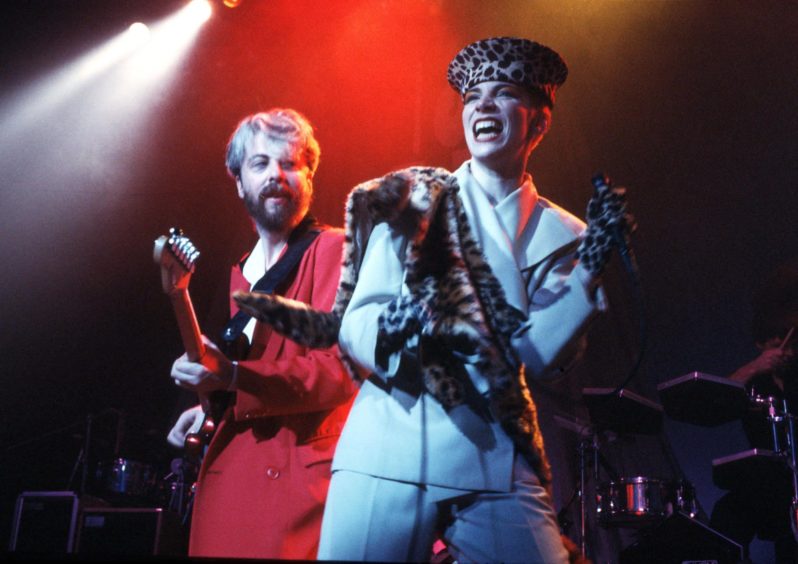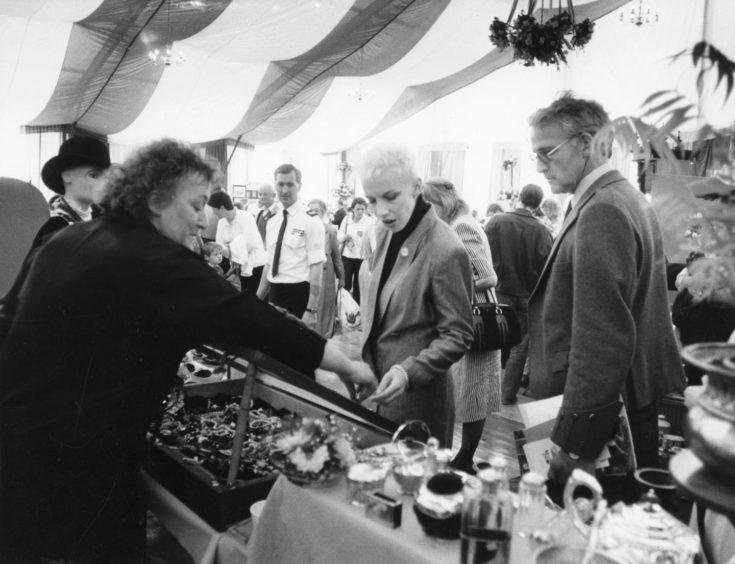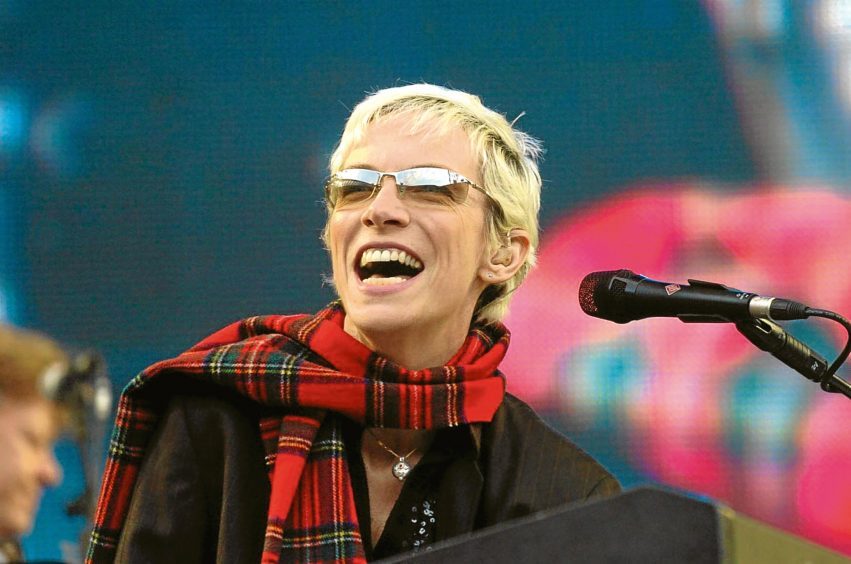The careers of most successful pop and rock groups tend to follow a similar trajectory; initial harmony and common purpose before the relationship gradually breaks down.
Few bands, especially when they involve only two members, decide to split up before they have even released a single song, and especially not in a remote Australian location such as Wagga Wagga in New South Wales.
Yet, that’s what happened when Annie Lennox and Dave Stewart made their escape from The Tourists and created the Eurythmics 40 years ago, as the prelude to producing some of the biggest hits of the 1980s.
Choir
It’s a remarkable story, but there again, this duo could never remotely be described as conventional. Annie, born on Christmas Day in Aberdeen in 1954, excelled at music, poetry and art, and entertained aspirations of becoming a professional flautist, while she was growing up as part of a working-class family in the Granite City.
Top of the Pops was the last thing on her mind at that stage.
Instead, the pupil at Aberdeen High School for Girls (which later became Harlaw Academy), sang in the choir, performed in symphony ensembles and attended dance classes which were run by teacher Marguerite Feltges.
One of the disciplines was a Greek dance called Eurhythmics – and so it was that a decade later, and minus a superfluous ‘h’, Annie made one of the pivotal decisions of her life.
When she originally travelled to London to study at the Royal Academy of Music, the north-east teenager was, by her own admission, “naive” and “idealistic”.
Being an only child from a rigid background, she quickly realised the relocation was a daunting prospect.
As she said: “It was very hard because I had so little money – really, almost nothing. It was a huge city and, coming down to a place where you have no friends, and nobody to relate to other than the students you just happen to meet at college, is very isolating.”
Many others in her position might have dashed home to Scotland, but Annie has always been a tenacious character.
She began combining her studies with a job in a health food store – and it wasn’t long before she was making an impression on Dave Stewart.
He recalled: “She was more Laura Ashley dresses and longish brown hair at the start. When I first went to her tiny bedsit, she sang a song which she had written on a harmonium.
“I was like ‘Holy s***, what are you doing as a waitress? You’re an artist.”
These early years passed in a giddy whirl and after the couple joined The Tourists, they were blessed with near instant stardom, including coverage in New Musical Express, Melody Maker and Sounds, while the band celebrated regular chart success with The Loneliest Man in the World, I Only Want to Be with You and So Good to be Back Home Again.
Top 10
The latter brace reached the top 10 in Britain and sold in prodigious amounts.
As the lead vocalist, with a striking appearance and apparent swagger – although, behind the scenes, she was painfully shy – Annie was the prime focus of attention and it often rested uneasily on her shoulders.
Nor was she helped by the frequently unwelcome treatment which was routinely meted out to female artists many decades before the #MeToo movement.
Dave said later: “During the punk period, being a woman wearing a skirt was pretty wild.
“Lots of people were leering and sexist.”
The Tourists splintered and fragmented nearly as rapidly as they had leapt into the spotlight.
And the fact it happened on the other side of the world only increased the sense of bewilderment and what happens next.
These scenarios can be akin to the acclaimed film Rashomon where different people put their own perspective on one event and their memories can prove contradictory.
The Tourists weren’t enjoying the journey.
Their principal songwriter, Pete Coombes, was a drug addict whose erratic personal trips eventually helped derail the whole group.
Dave recalled: “Annie and I went to Australia, but the band broke up and we ended up in a hotel in Wagga Wagga. I had a little Wasp synthesiser, and was making didgeridoo sounds.
“When Annie started singing along to these, we thought: ‘Maybe we could make weird and experimental music together’.
“On the flight home, we split up as a couple, but kept on with the music, carting the gear around in a second-hand horse box. At one early gig, we played to four people, drove home through the night in the snow, and had to stop the car.
“I realised we needed some proper equipment, so we went to see the bank manager. Sat in his office, we were this odd couple. But amazingly, he lent us £5,000.”
Candid struggle
On another day, with a more cautious or parsimonious person behind that desk, the whole Eurythmics project might have crashed before it even took flight.
Annie, for her part, was candid about the struggle which confronted the duo.
Their initial album, In the Garden, recorded in Cologne and released in 1981, contained plenty of electronic material – with the involvement of Kraftwerk producer Conny Plank – but it was poorly promoted, lacked any obvious singles material and garnered lukewarm reviews.
In the post-punk milieu, one-hit wonders and two-chord merchants with all the permanency of a snowman were clogging up the charts and gimmicks often transcended genuine talent.
The Scot, for all her resilience and a singing voice which would eventually be recognised on both sides of the Atlantic as a thing of beauty, was beginning to wonder if she and Dave would ever bring all the necessary components together to make the breakthrough.
And that sinking feeling of quiet desperation filtered through into their writing, which was the catalyst for one of the most successful – but most misunderstood – songs in the history of popular music.
Annie described it thus: “It’s basically me saying ‘Look at the state of us. How can it get any worse?’ The song was an expression of how I felt: hopeless and nihilistic.”
The song in question was Sweet Dreams (Are Made of This)!
All the myriad pain, privations and pitfalls endured by the duo while they were living in dodgy bedsits and dealing with shady characters finally reaped dividends, yet strangely enough, the title track of their LP was the fourth – and final – track from the album to be released as a single.
It soon became their breakthrough hit, established the duo worldwide, its music video helped propel the song to number 2 on the UK Singles Chart and number 1 on the US Billboard Hot 100.
It was the first single released by Eurythmics in the United States and had such a lasting impact that the song was inducted into the Grammy Hall of Fame earlier this year.
Struck a chord
Many people have regarded it as a paean to positivity, while Annie even explained that she met listeners who thought the lyrics were: “Sweet dreams are made of cheese”.
But it struck a chord with millions of listeners across the world.
As she said of the lyrics in Sweet Dreams: “‘I travelled the world and the seven seas, everybody’s looking for something’ was about how we are all in a perpetual state of seeking.
“It’s about surviving the world. It’s not a normal song so much as a weird mantra that goes round and round, but somehow it became our theme song.
“And, apparently, it’s the most misheard lyric in British pop.”
The pair were never easily pigeon-holed, which perhaps added to their allure.
Determined to be the opposite of the stereotypical female singer, Annie resolved that she would be as strong and powerful a presence in everything the Eurythmics did as Dave. And it worked. She wore suits, cropped her hair, occasionally resembled Bowie and at other times Kate Bush.
The hits arrived as if on a conveyor belt, both in Britain and the US, including Who’s That Girl, Here Comes the Rain Again, There Must Be an Angel, It’s Alright (Baby’s Coming Back), Would I Lie to You, Angel and Right By Your Side.
Not many singers were asked to share their vocal skills next to the powerhouse Aretha Franklin – the First Lady of Soul – on a duet, but Annie didn’t need any second invitation.
And even today, there’s such a timeless quality to Sisters (Are Doing It for Themselves) and it has become a rallying cry for women of all ages and backgrounds wherever it is played.
Separate ways
Living hard will take its toll though and, even as Eurythmics entered into strenuous years of touring and recording, including eight albums in less than a decade, the news emerged in 1990 that they were heading their separate ways.
It didn’t mean an end to the music, and the band’s Greatest Hits collection entered the UK chart at No 1 in 1991 and spent no less than 10 weeks at the summit.
Soon enough, Annie unveiled her debut solo album with the wonderful title Diva and it shifted a few copies.
Or, to put it another more accurate way, it achieved quadruple platinum status – selling more than any Eurythmics album – and propelled her into the stratosphere, not only in music, but on a range of political and women’s issues.
After almost a decade apart, they reunited to create a new CD, Peace, as the millennium beckoned. And the honours and accolades testify to their global renown.
Annie has won more Brit awards than any other female artist in history, but her life changed in 2003 when she met Nelson Mandela in South Africa to participate in a launch concert for the HIV/AIDS Foundation 46664.
It was a world removed from her early days in Aberdeen when her parents warned her she would “end up in a factory” if she didn’t concentrate on studying and doing her homework.
In the end, the capricious dreamer survived the early traumas in London to become one of her country’s most instantly recognisable stars, but she has remained grounded and interested in social causes; a throwback to her childhood which she investigated when she appeared on the BBC programme Who Do You Think You Are in 2012.
She and Dave were both thankful for the bank loan which sparked their very sweet dreams.
As she concluded: “At the very beginning, when we were trying to make this music together in the Eurythmics, at the core of it all was the urge to create something of value and meaning that people would connect to and would affect them.
“Now, when I am out and I meet people in the street, they will say things like: ‘Wow, I grew up with your music’.
“I don’t know them, but they know me through the music, so clearly it worked.”
